Development of an Application That Implements a Brain–Computer Interface to an Upper-Limb Motor Assistance Robot to Facilitate Active Exercise in Patients: A Feasibility Study
Abstract
:1. Introduction
2. Materials and Methods
2.1. Outline of the Method
2.2. Participants
2.3. EEG Measurement
2.4. EEG Analysis
2.4.1. EEG Data Conversion Procedure
- EEG data were converted into CSV files without filtering from the EEG detection.
- The CSV files were converted to CAL files compatible with the DiC application using a data converter application.
- In the CAL files, according to the MI protocol, potential data were associated with binary data of 1 during the MI period and 0 during the rest period.
- The CAL files were loaded into the DiC application, and the MSM and RP classifiers were created.
- In the MSM, the ERD transition probability was derived from four events: the true-positive rate (TPR), false-positive rate (FPR), true-negative rate (TNR), and false-negative rate (FNR).
- In RP, the ERD was derived by calculating the root mean square (RMS) from the resting potential and dividing it by the EEG potential.
- The EEG threshold for ERD appearance was set as the signal that activated the DiC; therefore, the ERD appearance probability for MSM and the rate of change based on the resting EEG for RP were used.
- The CAL files were loaded again into the DiC application, and when the MSM or RP threshold was exceeded, a signal was sent to control the DiC, and the DiC arm was activated.
2.4.2. Detecting ERD
2.4.3. ERD Calculation with RP
2.5. The DiC
2.6. Reaction Time of the DiC
2.7. Sample Size
2.8. Statistical Analysis
2.9. Methods for Exclusion of Missing Data and Outliers for the Reaction Time from the EEG Playback to ERD Detection
2.10. Patients’ Subjective Evaluation of MI
2.11. Method for Analyzing the Relationship between the Subjective Quality of MI and the Time from EEG Playback to ERD Detection
3. Results
3.1. Participant Analysis
3.2. Descriptive Data Regarding the Participants
3.3. ERD Detection during MI
3.4. Comparison of the Reaction Time between the MSM and RP
3.5. Relationship between the Subjective Quality of MI and the Reaction Time of the DiC
4. Discussion
4.1. ERD Detection during MI in Patients with Severe Post-Stroke Hemiplegia
4.2. Implementation of BCI Application by the MSM and RP
4.3. Limitations
5. Conclusions
6. Patents
Author Contributions
Funding
Institutional Review Board Statement
Informed Consent Statement
Data Availability Statement
Acknowledgments
Conflicts of Interest
Abbreviations
References
- Samar, M.; Saussez, G.; della Faille, M.; Prist, V.; Zhang, X.; Dispa, D.; Bleyenheuft, Y. Rehabilitation of motor function after stroke: A multiple systematic review focused on techniques to stimulate upper extremity recovery. Front. Human Neurosci. 2016, 10, 442. [Google Scholar] [CrossRef]
- Thrane, G.; Emaus, N.; Askim, T.; Anke, A. Arm use in patients with subacute stroke monitored by accelerometry: Association with motor impairment and influence on self-dependence. J. Rehabil. Med. 2011, 43, 299–304. [Google Scholar] [CrossRef]
- Nudo, R.J.; Milliken, G.W.; Jenkins, W.M.; Merzenich, M.M. Use-dependent alterations of movement representations in primary motor cortex of adult squirrel monkeys. J. Neurosci. 1996, 16, 785–807. [Google Scholar] [CrossRef] [PubMed]
- Schaechter, J.D.; Kraft, E.; Hilliard, T.S.; Dijkhuizen, R.M.; Benner, T.; Finklestein, S.P.; Rosen, B.R.; Crame, S.C. Motor recovery and cortical reorganization after constraint-induced movement therapy in stroke patients: A preliminary study. Neurorehabilit. Neural Repair 2002, 16, 326–338. [Google Scholar] [CrossRef] [PubMed]
- Fetz, E.E.; Finocchio, D.V.; Baker, M.A.; Soso, M.J. Sensory and motor responses of precentral cortex cells during comparable passive and active joint movements. J. Neurophysiol. 1980, 43, 1070–1089. [Google Scholar] [CrossRef] [PubMed]
- Chien, W.-T.; Chong, Y.-Y.; Tse, M.-K.; Chien, C.-W.; Cheng, H.-Y. Robot-assisted therapy for upper-limb rehabilitation in subacute stroke patients: A systematic review and meta-analysis. Brain Behav. 2020, 10, e01742. [Google Scholar] [CrossRef]
- Xia, W.; Dai, R.; Xu, X.; Huai, B.; Bai, Z.; Zhang, J.; Jin, M.; Niu, W. Cortical mapping of active and passive upper limb training in stroke patients and healthy people: A functional near-infrared spectroscopy study. Brain Res. 2022, 1788, 147935. [Google Scholar] [CrossRef]
- Ameur, L.; Ridha, K.; Ahmed, C. AI-based Human Tracking for Remote Rehabilitation Progress Monitoring. In Proceedings of the ICAECE 2023—International Conference on Advances in Electrical and Computer Engineering, Tebessa, Algeria, 15–16 May 2023. HAL ID: lirmm-04107931. [Google Scholar]
- Johanna, R.O.; Livia, N. Design of a mobile game application to support hand rehabilitation of stroke patients in Indonesia. Int. J. Technol. 2017, 2, 250–261. [Google Scholar] [CrossRef]
- Ferriero, G.; Sartorio, F.; Foti, C.; Primavera, D.; Brigatti, E.; Vercelli, S. Reliability of a new application for smartphones (DrGoniometer) for elbow angle measurement. PM&R 2011, 3, 1153–1154. [Google Scholar] [CrossRef]
- Ameur, L.; Ridha, K.; Ahmed, C.; Adlen, K. Reliability and validity analysis of MediaPipe-based measurement system for some human rehabilitation motions. Measurement 2023, 214, 112826. [Google Scholar] [CrossRef]
- Baniqued, P.D.E.; Stanyer, E.C.; Awais, M.; Alazmani, A.; Jackson, A.E.; Mon Williams, M.A.; Mushtaq, F.; Holt, R.J. Brain–computer interface robotics for hand rehabilitation after stroke: A systematic review. J. Neuroeng. Rehabil. 2021, 18, 15. [Google Scholar] [CrossRef] [PubMed]
- Ang, K.K.; Chua, K.S.G.; Phua, K.S.; Wang, C.; Chin, Z.Y.; Kuah, C.W.K.; Low, W.; Guan, C. A randomized controlled trial of EEG-based motor imagery brain-computer interface robotic rehabilitation for stroke. Clin. EEG Neurosci. 2015, 46, 310–320. [Google Scholar] [CrossRef] [PubMed]
- Hanakawa, T.; Immisch, I.; Toma, K.; Dimyan, M.A.; Van Gelderen, P.; Hallett, M. Functional properties of brain areas associated with motor execution and imagery. J. Neurophysiol. 2003, 89, 989–1002. [Google Scholar] [CrossRef] [PubMed]
- Li, F.; Peng, W.; Jiang, Y.; Song, L.; Liao, Y.; Yi, C.; Zhang, L.; Si, Y.; Zhang, T.; Wang, F.; et al. The dynamic brain networks of motor imagery: Time-varying causality analysis of scalp EEG. Int. J. Neural Syst. 2019, 29, 1850016. [Google Scholar] [CrossRef]
- Saito, Y.; Suzuki, M.; Koike, Y.; Koizumi, K.; Nakaya, N.; Abo, M.; Hamaguchi, T. Reproducibility between robot and human movements: Preliminary development of a robotic device reconstructing therapeutic motion. J. Ergon. Technol. 2020, 20, 10–19. [Google Scholar]
- Jia, J. Exploration on neurobiological mechanisms of the central–peripheral–central closed-loop rehabilitation. Front. Cell Neurosci. 2022, 16, 982881. [Google Scholar] [CrossRef]
- López-Larraz, E.; Sarasola-Sanz, A.; Irastorza-Landa, N.; Birbaumer, N.; Ramos-Murguialday, A. Brain-machine interfaces for rehabilitation in stroke: A review. NeuroRehabilitation 2018, 43, 77–97. [Google Scholar] [CrossRef]
- Newbold, D.J.; Laumann, T.O.; Hoyt, C.R.; Hampton, J.M.; Montez, D.F.; Raut, R.V.; Ortega, M.; Mitra, A.; Nielsen, V.; Miller, D.B.; et al. Plasticity and spontaneous activity pulses in disused human brain circuits. Neuron 2020, 107, 580–589. [Google Scholar] [CrossRef]
- Zhang, J.; Wang, M. A survey on robots controlled by motor imagery brain-computer interfaces. Cogn. Robot. 2021, 1, 12–24. [Google Scholar] [CrossRef]
- Lisi, G.; Rivela, D.; Takai, A.; Morimoto, J. Markov switching model for quick detection of event related desynchronization in EEG. Front. Neurosci. 2018, 12, 24. [Google Scholar] [CrossRef]
- Paszkiel, S.; Dobrakowski, P. Brain–computer technology-based training system in the field of motor imagery. IET Sci. Meas. Technol. 2020, 14, 1014–1018. [Google Scholar] [CrossRef]
- Pfurtschellera, G.; Lopes da Silva, F.H. Event-related EEG/MEG synchronization and desynchronization: Basic principles. Clin. Neurophysiol. 1999, 110, 1842–1857. [Google Scholar] [CrossRef] [PubMed]
- Toriyama, H.; Ushiba, J.; Ushiyama, J. Subjective Vividness of Kinesthetic Motor Imagery Is Associated with the Similarity in Magnitude of Sensorimotor Event-Related Desynchronization Between Motor Execution and Motor Imagery. Front. Neurosci. 2018, 12, 295. [Google Scholar] [CrossRef] [PubMed]
- Gomez-Rodriguez, M.; Grosse-Wentrup, M.; Gharabaghi, J.H.A.; Scholkopf, B.; Peters, J. Towards brain-robot interfaces in stroke rehabilitation. In Proceedings of the 2011 IEEE International Conference on Rehabilitation Robotics, Zurich, Switzerland, 29 June–1 July 2011; pp. 1–6. [Google Scholar] [CrossRef]
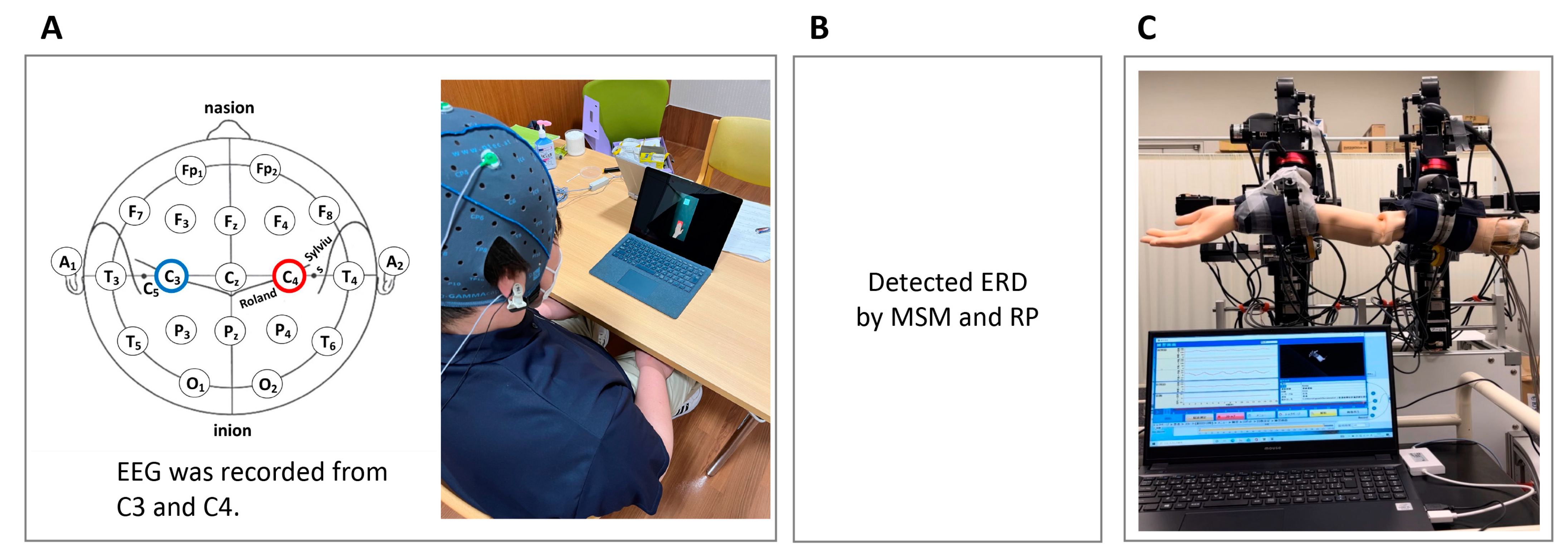
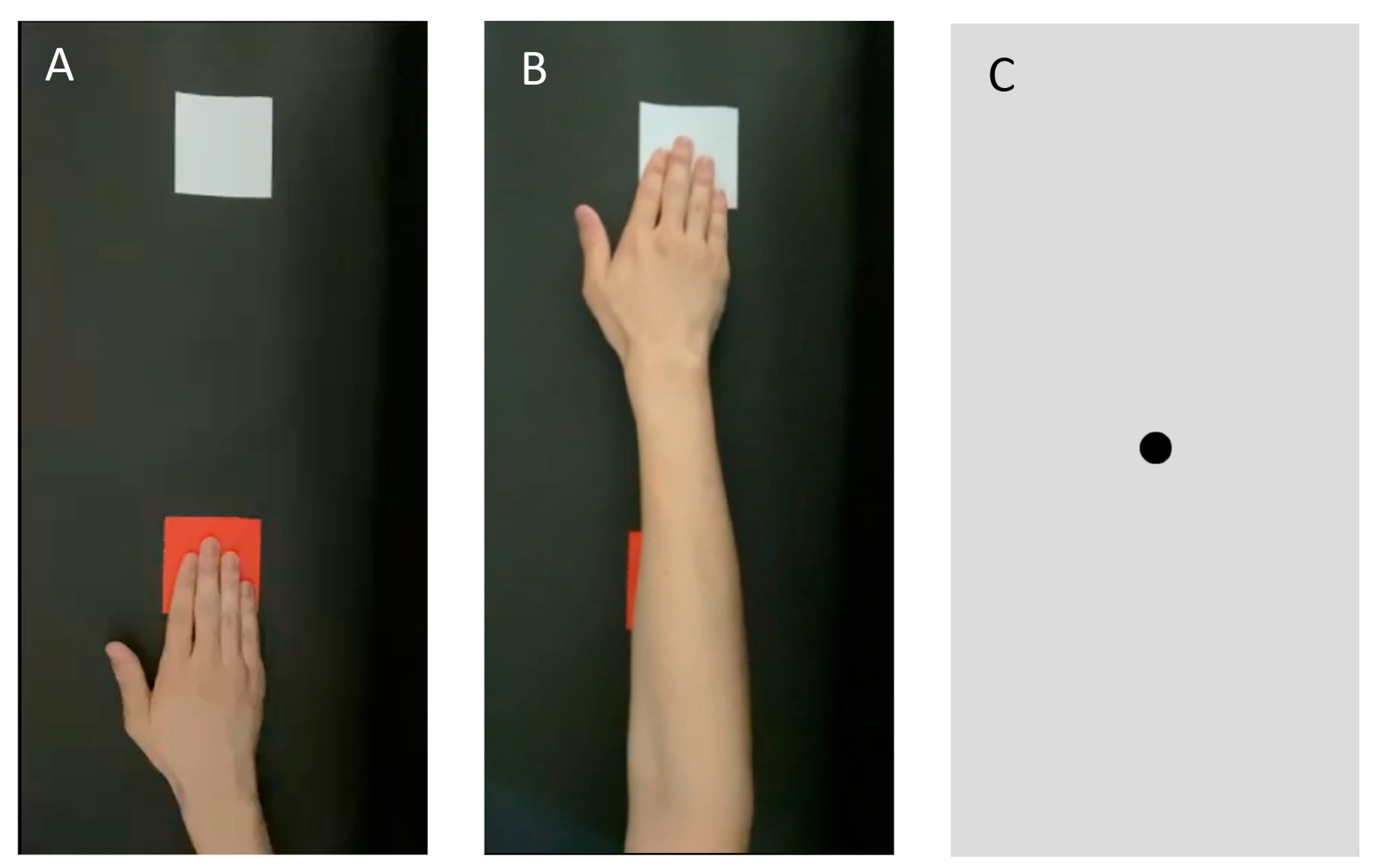
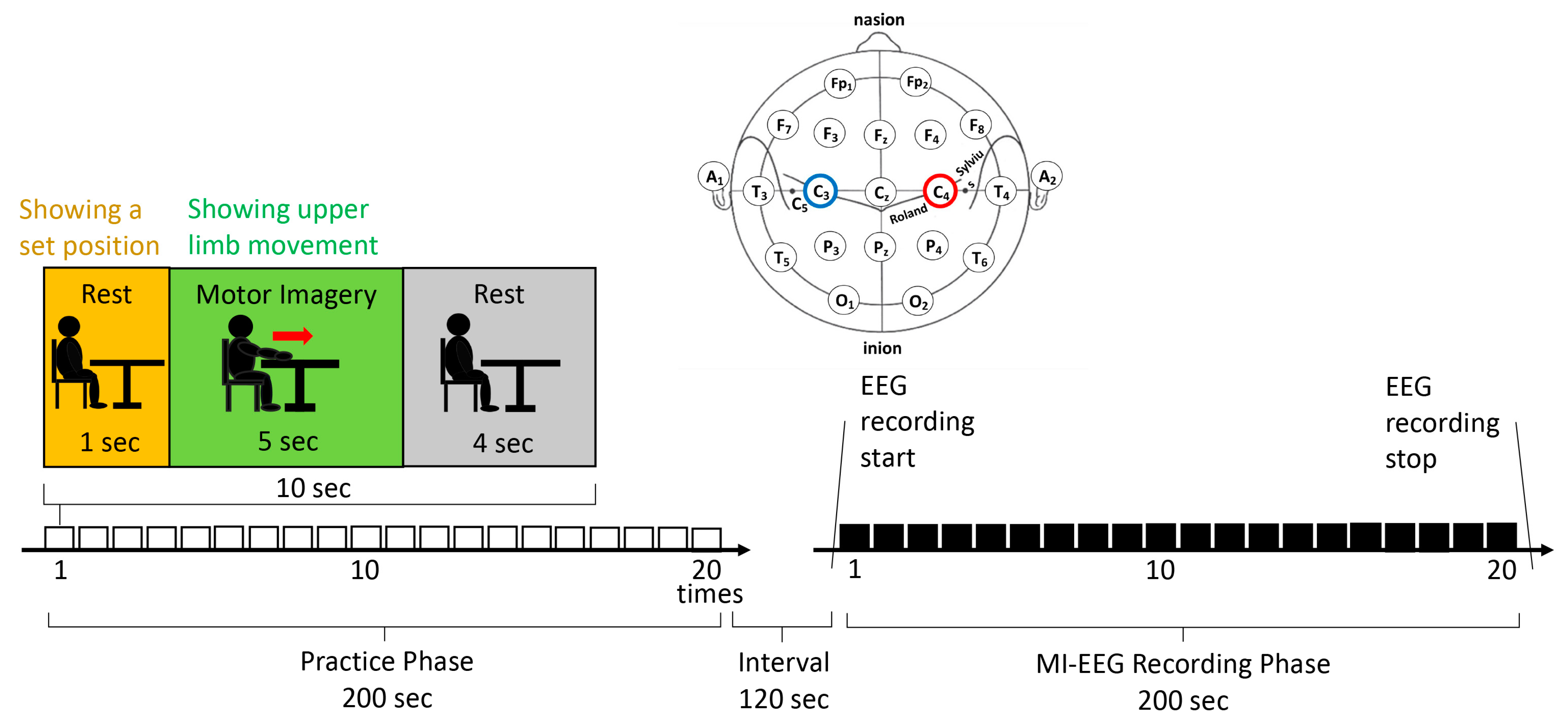
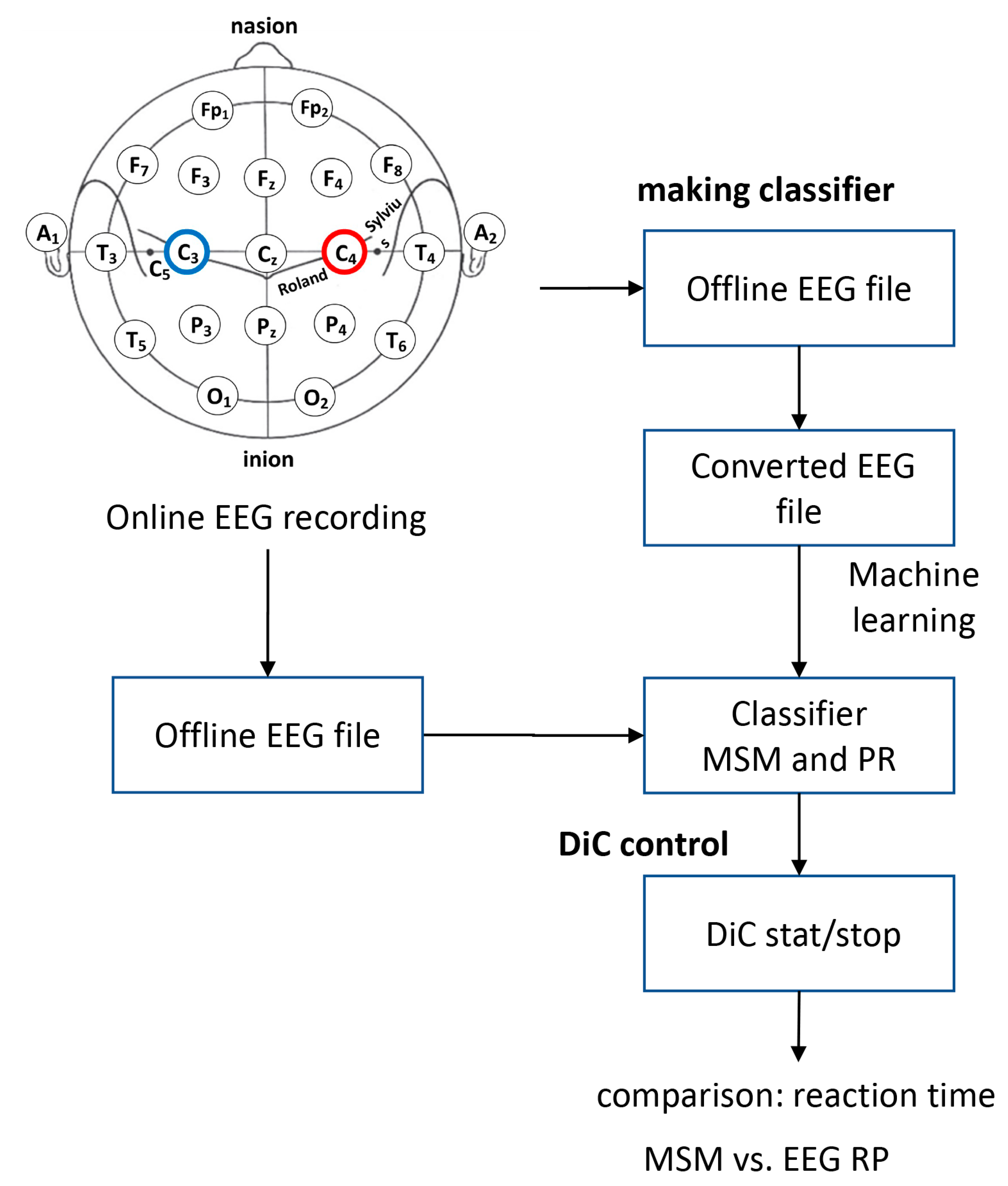

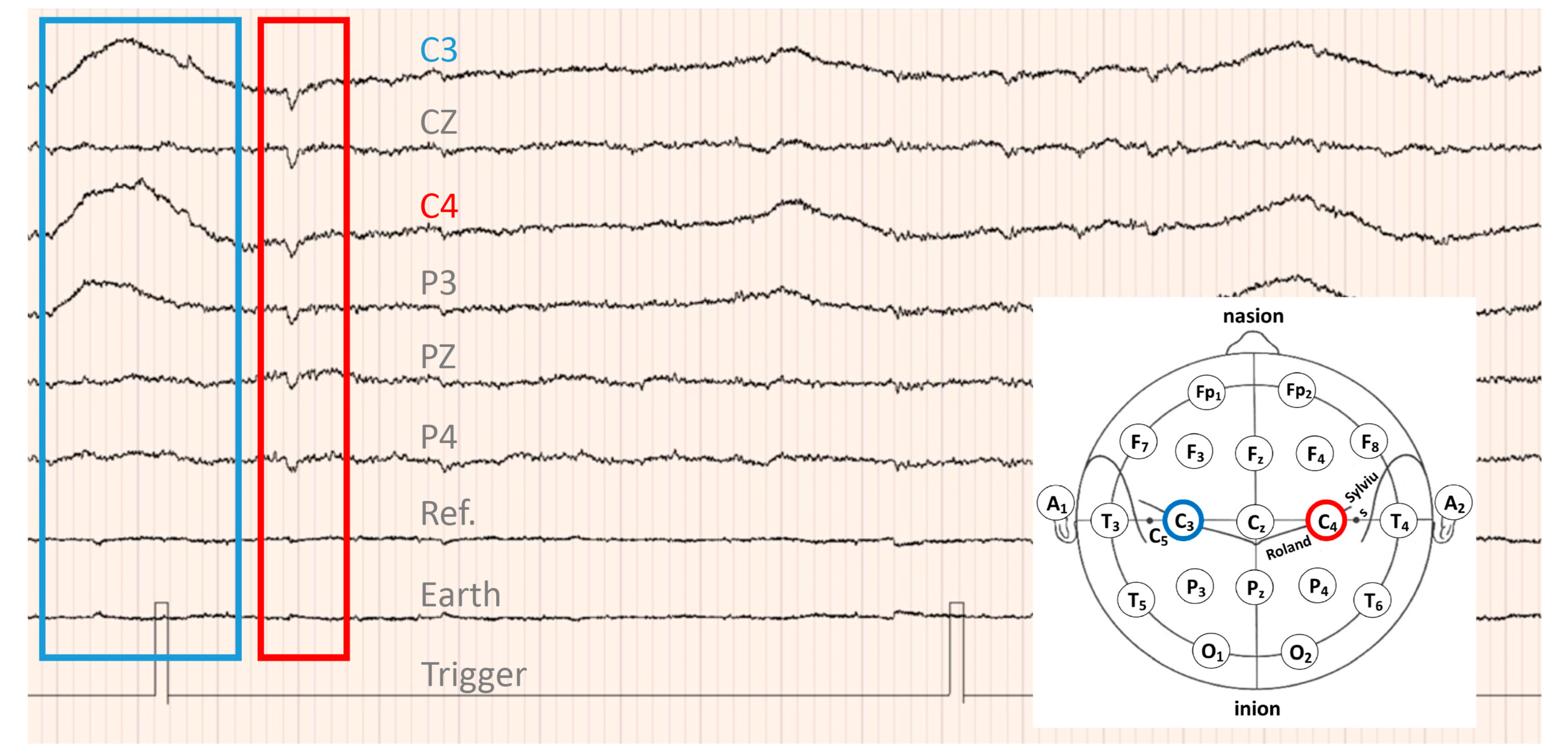
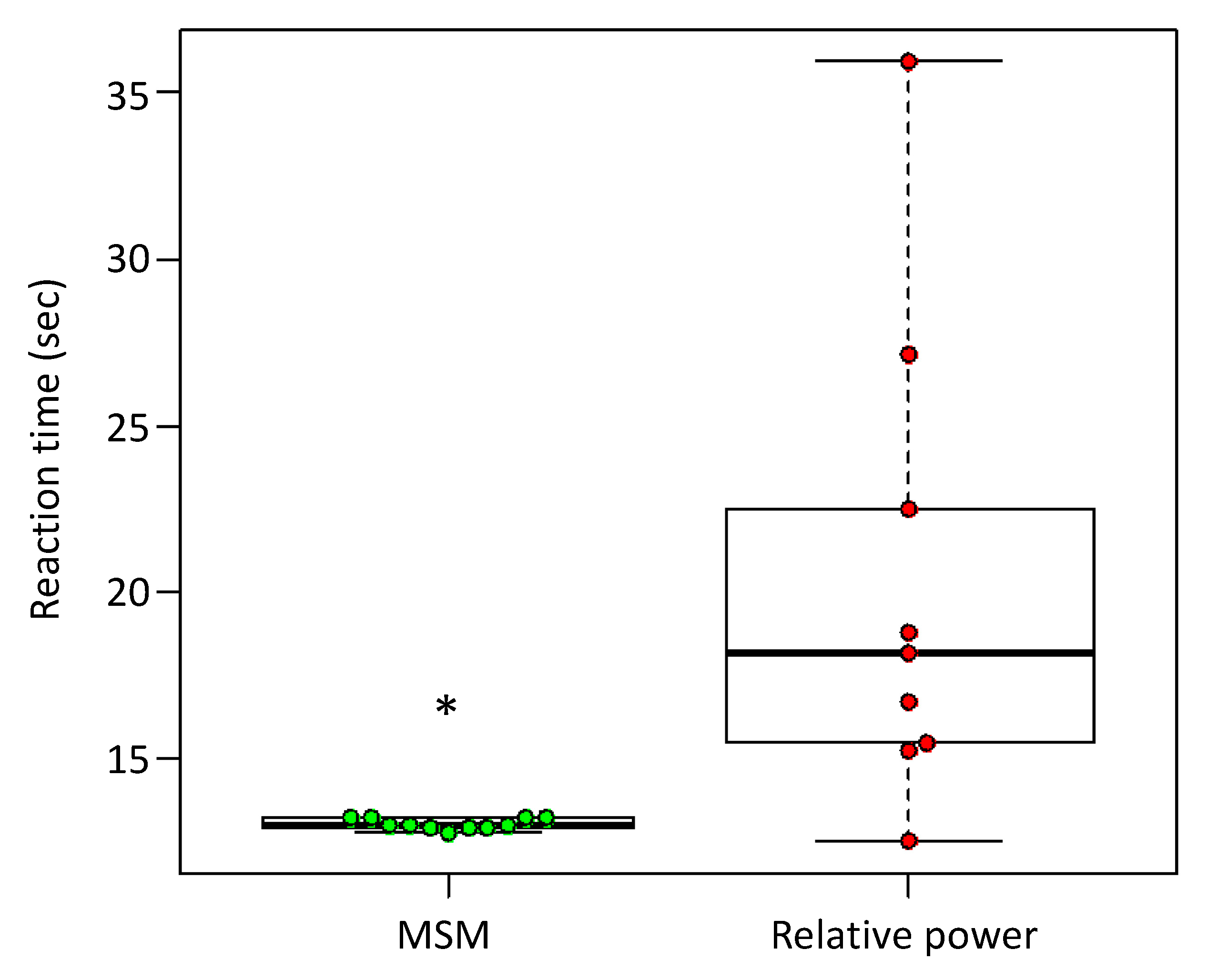
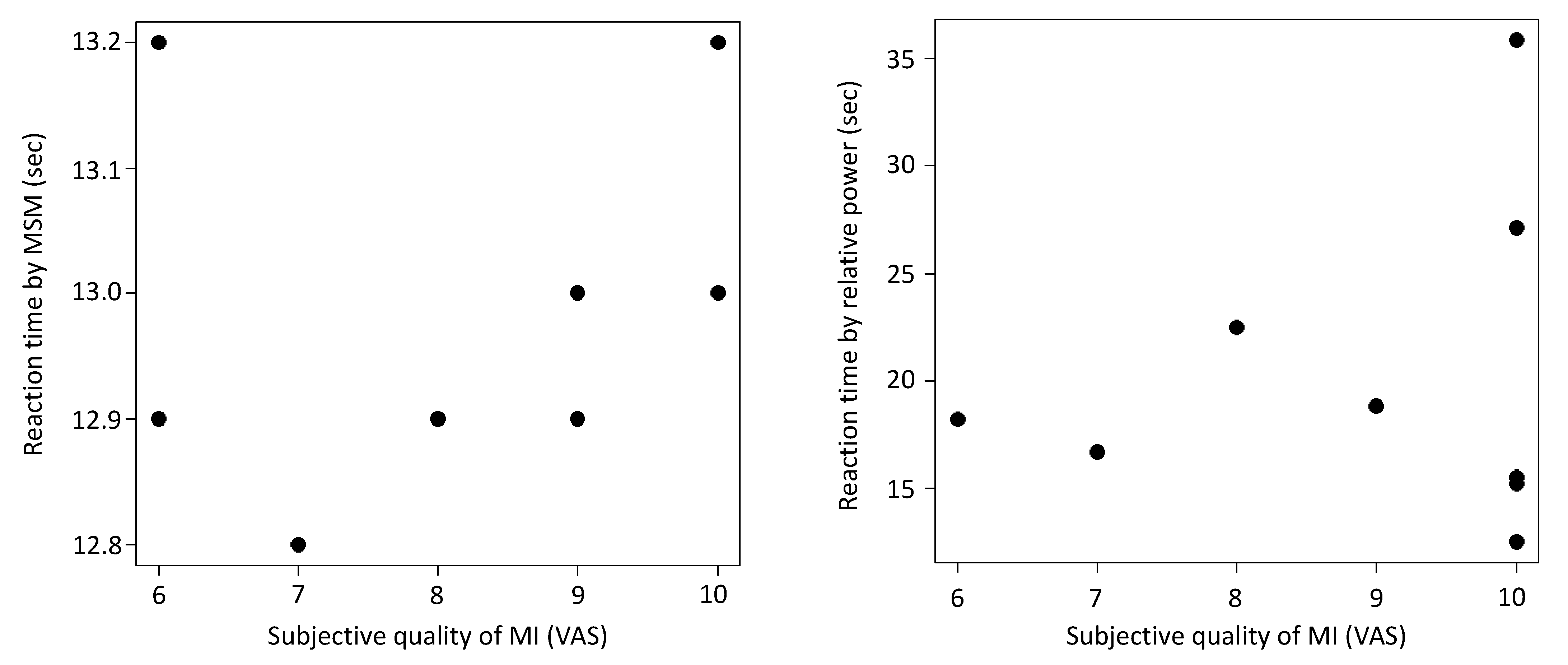
| No. | Sex | Age | Handedness | Height | Weight | Days after Onset | Diagnosis | Side | Lesion |
|---|---|---|---|---|---|---|---|---|---|
| 1 | Male | 53 | Right | 171 | 78.6 | 29 | Hemorrhage | Left | Putamen |
| 2 | Female | 47 | Right | 153 | 59.1 | 44 | Hemorrhage | Bilateral | Putamen |
| 3 | Male | 78 | Right | 153 | 51.6 | 75 | Infarction | Right | Basal ganglia |
| 4 | Male | 77 | Right | 171.5 | 58.5 | 107 | Hemorrhage | Right | Putamen |
| 5 | Female | 77 | Right | 144 | 48.6 | 109 | Infarction | Right | Corona radiata |
| 6 | Female | 46 | Right | 154 | 64.7 | 84 | Hemorrhage | Right | Putamen |
| 7 | Male | 79 | Right | 153 | 57 | 37 | Infarction | Light | Corona radiata |
| 8 | Male | 81 | Right | 157 | 59.9 | 77 | Infarction | Right | Corona radiata |
| 9 | Male | 75 | Right | 167 | 43.5 | 85 | Infarction | Left | Internal capsule |
| 10 | Male | 55 | Right | 173 | 58.2 | 42 | Infarction | Left | ACA, MCA |
| 11 | Male | 62 | Right | 167 | 58 | 128 | Hemorrhage | Right | Putamen |
| 12 | Male | 63 | Right | 174 | 60.3 | 194 | Hemorrhage | Left | Thalamus |
| 13 | Male | 41 | Right | 175 | 83.9 | 110 | Hemorrhage | Right | Putamen |
| No. | FMA-UE | MMSE | MI Quality (VAS) | Reaction Time | |
|---|---|---|---|---|---|
| MSM | RP | ||||
| 1 | 8 | 29 | 10 | 12.3 | − |
| 2 | 6 | 28 | 9 | 12.9 | 52.6 |
| 3 | 11 | 26 | 6 | 13.2 | 18.2 |
| 4 | 9 | 24 | 8 | 12.9 | 22.5 |
| 5 | 8 | 30 | 10 | 13.2 | 35.9 |
| 6 | 4 | 28 | 7 | 12.8 | 16.7 |
| 7 | 7 | 27 | 6 | 12.9 | 91.1 |
| 8 | 7 | 29 | 10 | 13.2 | 15.2 |
| 9 | 8 | 27 | 1 | 12.9 | 15.4 |
| 10 | 9 | 25 | 10 | 13.2 | 15.5 |
| 11 | 4 | 30 | 9 | 13.0 | 18.8 |
| 12 | 12 | 28 | 10 | 13.0 | 27.1 |
| 13 | 12 | 30 | 10 | 13.0 | 12.5 |
Disclaimer/Publisher’s Note: The statements, opinions and data contained in all publications are solely those of the individual author(s) and contributor(s) and not of MDPI and/or the editor(s). MDPI and/or the editor(s) disclaim responsibility for any injury to people or property resulting from any ideas, methods, instructions or products referred to in the content. |
© 2023 by the authors. Licensee MDPI, Basel, Switzerland. This article is an open access article distributed under the terms and conditions of the Creative Commons Attribution (CC BY) license (https://creativecommons.org/licenses/by/4.0/).
Share and Cite
Yamamoto, T.; Hamaguchi, T. Development of an Application That Implements a Brain–Computer Interface to an Upper-Limb Motor Assistance Robot to Facilitate Active Exercise in Patients: A Feasibility Study. Appl. Sci. 2023, 13, 9979. https://doi.org/10.3390/app13179979
Yamamoto T, Hamaguchi T. Development of an Application That Implements a Brain–Computer Interface to an Upper-Limb Motor Assistance Robot to Facilitate Active Exercise in Patients: A Feasibility Study. Applied Sciences. 2023; 13(17):9979. https://doi.org/10.3390/app13179979
Chicago/Turabian StyleYamamoto, Tadashi, and Toyohiro Hamaguchi. 2023. "Development of an Application That Implements a Brain–Computer Interface to an Upper-Limb Motor Assistance Robot to Facilitate Active Exercise in Patients: A Feasibility Study" Applied Sciences 13, no. 17: 9979. https://doi.org/10.3390/app13179979
APA StyleYamamoto, T., & Hamaguchi, T. (2023). Development of an Application That Implements a Brain–Computer Interface to an Upper-Limb Motor Assistance Robot to Facilitate Active Exercise in Patients: A Feasibility Study. Applied Sciences, 13(17), 9979. https://doi.org/10.3390/app13179979






